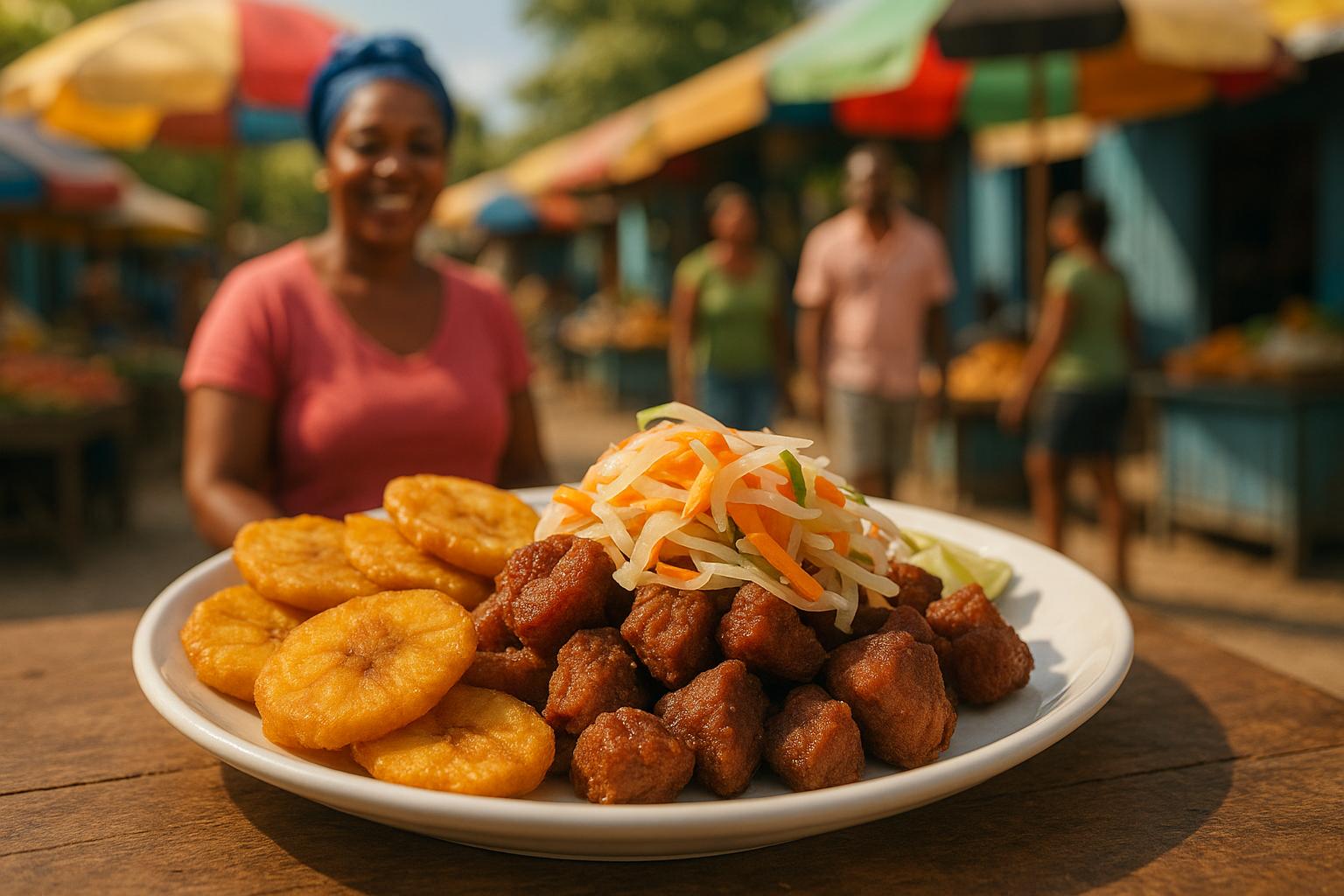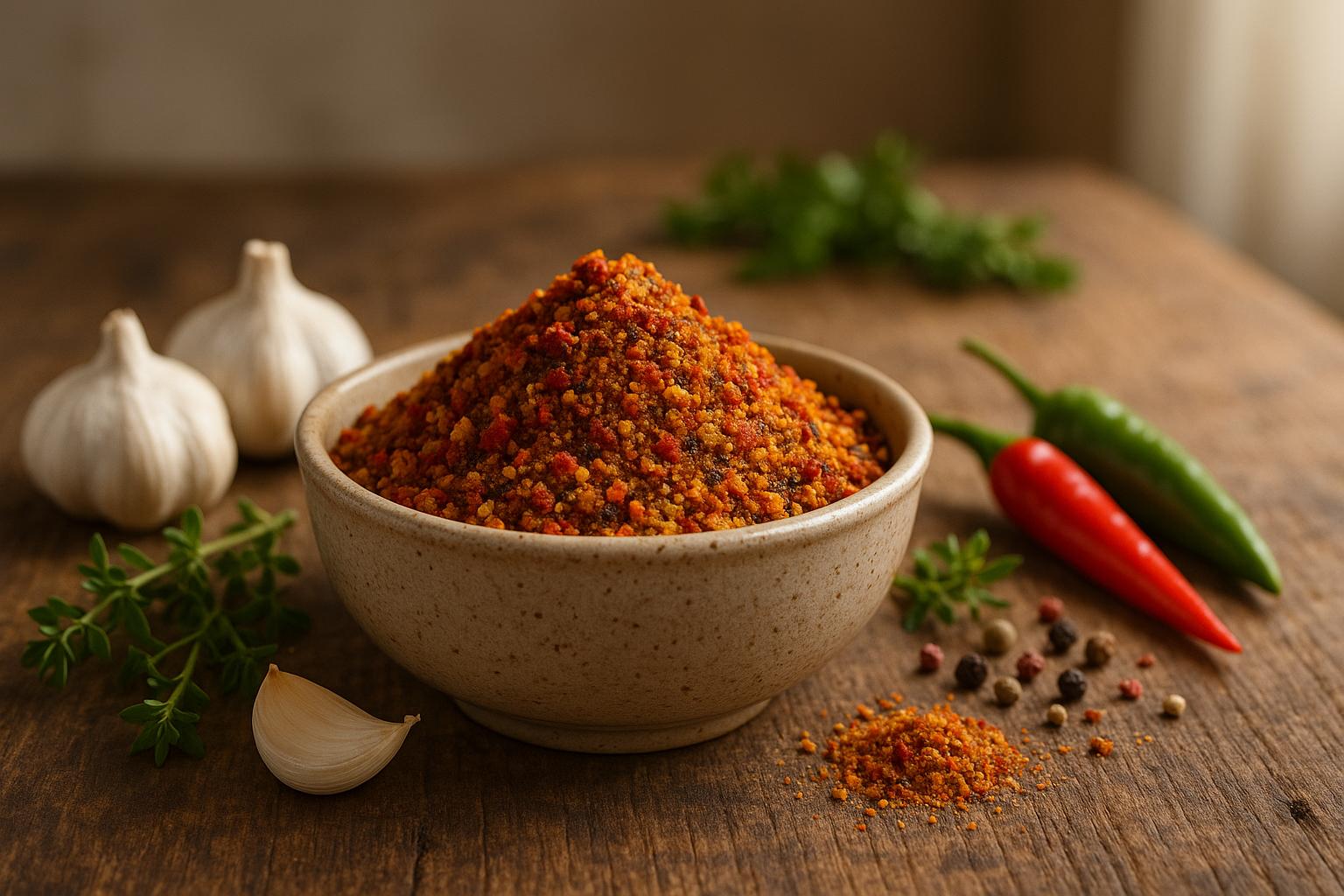Haitian rice and beans, known as Diri ak Pwa, is a flavorful dish that combines rice, beans, and a blend of herbs and spices. It’s a staple in Haitian cuisine, celebrated for its rich taste and historical roots. Here’s how you can make it:
Key Steps:
- Cook the Beans: Soak dried beans overnight, then simmer with garlic, thyme, and bouillon until tender. Reserve the cooking liquid for later.
- Prepare Aromatics: Sauté onions, garlic, green pepper, and Haitian seasoning (Epis) in oil. Add spices like cloves and optional dried shrimp for depth.
- Combine Rice and Beans: Add rinsed jasmine rice to the pot with the cooked beans. Pour the reserved bean liquid over the mixture, ensuring it covers the rice by about 1 inch.
- Simmer and Steam: Boil briefly, then reduce heat, cover, and cook until the rice absorbs the liquid (about 18–20 minutes). Let it rest before serving.
Ingredients:
- Rice: Long-grain jasmine rice
- Beans: Red kidney, black, or pinto beans
- Aromatics: Onion, garlic, green pepper, thyme, parsley
- Seasoning: Haitian Epis, cloves, Caribbean pepper (or Scotch Bonnet)
- Optional: Coconut milk for added creaminess
Tips:
- Use dried beans for the best flavor and texture.
- Rinse rice thoroughly to remove excess starch.
- Adjust heat levels with peppers to suit your taste.
Serve Diri ak Pwa as a main dish or pair it with proteins like chicken, fish, or fried pork (griot). For vegetarians, it works well with tofu or roasted vegetables. This dish is a flavorful way to connect with Haitian cooking and its rich culinary heritage.
HOW TO MAKE HAITIAN RICE & BEANS (DIRI KOLE AK PWA)
Ingredients and Substitutions
Diri ak Pwa (Haitian rice and beans) owes its signature flavor to a handful of key ingredients. While some traditional elements might not be readily available, you can still create an authentic version with a few smart substitutions. Here's a breakdown of what you'll need and how to adjust if necessary.
Essential Ingredients
At its core, this dish relies on long-grain jasmine rice, which absorbs flavor beautifully while maintaining the right texture. For the beans, you have options: red kidney beans, black beans, or pinto beans - all staples in Haitian cooking.
The flavor starts with a base of onion, shallot, garlic, and green pepper, complemented by Haitian green seasoning (Epis), a blend that defines the dish’s taste. Adding cloves and Caribbean pepper (commonly piment bouc or goat pepper) brings warmth and spice.
To balance these bold flavors, coconut milk provides a subtle sweetness, while fresh herbs like thyme and parsley add brightness. Proper preparation is also key: soak dried beans for at least 12 hours to soften them and make them easier to digest. And don’t skip rinsing your rice until the water runs clear - this step removes excess starch and ensures the rice cooks up perfectly.
Substitutions for U.S. Kitchens
If you can’t find certain traditional ingredients, don’t worry - there are plenty of alternatives available in most U.S. grocery stores.
- Beans: Canned beans are a convenient substitute for dried ones when you’re short on time, though the texture will be slightly softer.
- Spicy peppers: Swap out piment bouc for habanero or Scotch Bonnet peppers. Adjust the amount based on your heat tolerance.
- Epis: If you can’t get authentic Haitian Epis, sofrito makes a good replacement with a similar aromatic profile.
- Cooking fat: While olive oil is often used, vegetable oil works just as well.
- Rice: For a healthier twist, you can use brown rice instead of white. It adds extra fiber and protein, though it will slightly alter the texture.
Where to Shop
Most of the ingredients for Diri ak Pwa are easy to find at your local grocery store. Look in the international or Asian food aisle for items like coconut milk. Common staples like rice, beans, onions, garlic, and spices are widely available.
For more specialized ingredients - like authentic Epis, Caribbean spices, or Haitian vanilla essence - check out Caribbean or Latin American markets. These stores often stock harder-to-find items that can elevate your dish. If you don’t have access to these markets nearby, many online retailers carry authentic Haitian products, making it easier than ever to bring the flavors of Diri ak Pwa to your table.
Step-by-Step Cooking Instructions
With all your ingredients prepped and ready, it's time to dive into the process of making Diri ak Pwa. This dish is all about layering flavors at every stage, so take your time and enjoy the journey.
Preparing and Cooking the Beans
Start by rinsing your dried beans under cold water to remove any dirt or debris. After soaking them for 12 hours, they're ready to cook. Place the beans in a large pot and cover them with fresh water - about 2 inches above the beans.
Add 2–3 garlic cloves, a few sprigs of thyme, and a chicken or vegetable bouillon cube to the pot.
Bring the water to a boil over high heat, then reduce the heat to medium-low and let the beans simmer. Cook them for 45 minutes to an hour, or until they're tender but still firm enough to hold their shape. Avoid overcooking, as they'll continue to cook later with the rice.
"For best results with this recipe, I highly suggest using dry beans. Canned beans is another option to save time, but the results will be dramatically different." - Sendy Nervil, Sendy's Cookin [2]
Here's a critical tip: don't discard the bean cooking liquid! Strain the beans and set the liquid aside. This flavorful broth forms the base for cooking the rice and adds the dish’s signature taste and color.
With the beans cooked and the liquid reserved, you're ready to move on to the next step.
Cooking Aromatics and Building Flavor
Heat 2 tablespoons of vegetable oil in a large, heavy-bottomed pot over medium-high heat. Add diced onion, shallot, and green pepper - or 2–3 tablespoons of Epis, if you have it - and sauté for 2–3 minutes until the onions soften and the mixture becomes fragrant.
Next, stir in minced garlic and cook for about 30 seconds. If you're using whole spices like peppercorns, allspice, or cloves, grind them with a mortar and pestle for a more intense flavor and add them now.
Gently mix in the cooked beans, along with some crushed garlic cloves from earlier. If you're incorporating dried shrimp, now’s the time to add it for a savory, umami boost.
Season the mixture with salt, black pepper, and your preferred level of heat. For a milder flavor, add a whole habanero or Scotch Bonnet pepper; for more spice, make small cuts in the pepper before adding it. Fresh thyme and parsley sprigs can also be added at this stage to deepen the flavor.
Combining Rice and Beans
Once your beans and aromatics are bursting with flavor, it’s time to bring in the rice. Rinse the jasmine rice under cold water until the water runs clear - this step helps remove excess starch and prevents a sticky texture. Add the washed rice to the pot with the beans and aromatics.
Pour in the reserved bean cooking liquid, ensuring it's enough to cover the rice by about 1 inch. If you need more liquid, you can add water or even coconut milk for a richer taste. The liquid should have a deep reddish-brown hue.
"And, when adding the rice to the water, rice should always be above water. This is a Haitian secret for the best rice and beans." - Sendy Nervil, Sendy's Cookin [2]
Bring the pot to a rolling boil over high heat, then immediately lower the heat to a gentle simmer. Stir everything gently to ensure the flavors are evenly distributed, cover the pot with a tight-fitting lid, and cook on low for 18–20 minutes. Once cooked, remove the pot from the heat and let it rest for 5 minutes. This resting period allows the rice to finish steaming, giving it the perfect texture.
Before serving, taste and adjust the seasoning with salt and pepper as needed.
Note: Using canned beans may result in a lighter color for the dish.
sbb-itb-80c33ff
Serving Ideas and Recipe Variations
How to Serve This Dish
Diri ak Pwa can be enjoyed as either a main course or a hearty side dish, providing a complete protein source [3]. Its rich, savory flavors pair beautifully with traditional Haitian accompaniments.
Consider serving it alongside grilled chicken, fried plantains, vegetable or meat stews, or even sliced avocado for a touch of creaminess [1][3][4]. The sweetness of fried plantains creates a lovely contrast to the earthy, seasoned beans, while avocado adds a smooth, mellow texture that balances the dish’s bold flavors - especially if you decide to add a spicy kick.
These pairings not only enhance the dish but also open the door to experimenting with creative variations, as described below.
Different Ways to Make It
Diri ak Pwa is incredibly flexible, allowing for a variety of ingredient tweaks to suit your taste. You can switch up the beans - try red kidney, black, or pinto beans to explore different flavors and colors.
For a creamier twist, try substituting some of the bean liquid with coconut milk. Sendy Nervil’s version of the dish suggests using Loisa Sofrito, Loisa Organic Sazón, and Loisa Organic Adobo as convenient alternatives to homemade epis [2].
Want to add a tangy note? Diced tomatoes bring a touch of acidity [3]. If you’re a fan of heat, toss in some hot peppers [5]. For authenticity, stick to ingredients like scotch bonnet, garlic, and thyme [6]. To elevate the presentation, garnish with fresh herbs or extra vegetables - parsley, cilantro, or thyme sprigs are excellent choices [6].
Adjusting for Different Diets
This dish can easily be tailored to fit a range of dietary needs. For a vegan version, swap out chicken bouillon for vegetable bouillon [3].
If you’re looking to boost fiber and protein, substitute brown rice for white rice - just keep in mind that brown rice takes longer to cook. To cut down on fat, sauté onions and garlic in water or broth instead of oil. This reduces calories while keeping the dish flavorful. For those following plant-based diets, adding kombu (a type of sea vegetable) is optional but can provide a rich, umami depth [3].
These adjustments ensure the dish remains true to its Haitian roots while accommodating a variety of preferences and dietary choices.
Cooking Tips and Problem Solving
Common Problems and How to Fix Them
Even the most skilled cooks can sometimes run into texture issues when making Diri ak Pwa. If your rice turns out mushy, it’s worth tweaking the liquid measurements next time to get the texture just right. On the other hand, if the rice is undercooked, don’t worry - just add about ½ cup of water, cover the pot, and let it simmer gently for 10–15 minutes. Keep the heat low to avoid overcooking.
Once you’ve tackled any cooking hiccups, proper storage will help keep your dish tasting fresh and delicious.
Storing and Reheating Leftovers
To maintain the quality and safety of your Diri ak Pwa, transfer it to an airtight container and refrigerate it within two hours of cooking. It will stay fresh in the fridge for 3–6 days[3][7]. If you’d like to store it longer, divide it into portions and freeze them in resealable freezer bags. Flattening the bags makes defrosting easier and more even. Frozen portions are best used within six months[3][7]. For optimal results, let the rice cool in shallow containers before refrigerating.
When it’s time to reheat, add a splash of water, broth, or coconut milk to keep the rice moist. Stir halfway through reheating to ensure even warming[7].
Keeping the Flavor Right
The secret to preserving the authentic flavor lies in adjusting your seasonings as you cook. Taste frequently, and tweak the salt, pepper, and spices to your liking, keeping in mind that flavors will intensify as the liquid reduces.
If the dish tastes a bit bland at the end, a small pinch of salt or a squeeze of lime juice can bring it to life. For dishes that turn out too salty, stir in a little coconut milk or unsalted broth to balance the flavors.
And don’t forget about your leftover Epis or seasoning blend! You can store it in the refrigerator for up to a week or freeze it in an ice cube tray for easy, pre-portioned use in future recipes.
Final Thoughts and Next Steps
Traditional Haitian rice and beans isn't just a meal - it's a bridge to a heritage rich in resilience, community, and pride. Every step in the process, from soaking the beans overnight to rinsing the rice until the water runs clear, carries the essence of a story passed down through generations. Let the dish simmer undisturbed, and you'll find it captures more than just flavor - it embodies a legacy.
"Haitian food culture is an expression of identity, resilience, and community. It is the way we honor our history, celebrate life, and connect with each other. It's not just about food - it's about storytelling, pride, and preserving a legacy that blends African, Indigenous, French, and Caribbean influences" [9].
Now that you’ve mastered the basics, feel free to make this dish your own. Try experimenting with different types of beans or adjusting the spice level to suit your palate, all while staying true to the dish's roots. For a creamier, more indulgent twist, consider adding coconut milk - it’s a small change that can elevate the flavor.
But don’t stop with rice and beans. This recipe is a gateway to a world of Haitian cuisine. Dive into dishes like griyo, diri djon djon, or soup joumou, which was honored by UNESCO as an Intangible Cultural Heritage of Humanity in 2021 [8]. Each dish carries its own story, offering a deeper connection to Haiti's vibrant culinary traditions.
Start with your homemade epis seasoning - a cornerstone of Haitian cooking - and let it inspire your journey into new flavors and techniques. The true beauty of cooking lies not just in following a recipe but in understanding the meaning behind each step. By doing so, you become part of Haiti’s living culinary legacy, keeping its traditions alive and thriving.
FAQs
What can I use as a substitute for Haitian Epis if I can't find it in stores?
If you can't find Haitian Epis in your local stores, don't worry - you can whip up a similar blend with ingredients you likely already have. Start with garlic, parsley, thyme, scallions, and a touch of vinegar to capture that herbal and tangy essence. For some heat, add Scotch Bonnet peppers, habaneros, or even a dash of cayenne pepper. Tweak the amounts to match your flavor preferences, then blend everything into a paste for a close substitute.
How can I adjust the spice level in Haitian rice and beans (Diri ak Pwa) to match my taste?
To tweak the spice level of Diri ak Pwa, you can easily adjust the amount of hot peppers, such as Scotch bonnet or Habanero. Prefer a milder kick? Use fewer peppers or take out the seeds before cooking. If the heat ends up being too much, balance it out by adding extra water or pairing the dish with something cooling, like avocado or a spoonful of sour cream. On the other hand, if you’re craving more heat, finish it off with a splash of your favorite hot sauce.
What are some traditional Haitian dishes to serve with rice and beans?
Haitian rice and beans, or Diri ak Pwa, is a versatile dish that complements a range of traditional Haitian favorites. It's often served with bouillon, a hearty stew brimming with meat and vegetables, or griyo, the crispy and savory fried pork that's a staple in Haitian cooking. Other popular pairings include roasted or stewed chicken, fried fish, and braised beef, each bringing its own depth of flavor to the table.
To elevate the meal further, you can add pikliz, a spicy pickled vegetable relish that brings a tangy kick, or banan peze, perfectly fried plantains that add a touch of sweetness and crunch. Together, these combinations showcase the bold and vibrant flavors that make Haitian cuisine so memorable.


